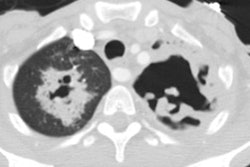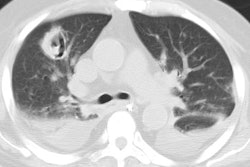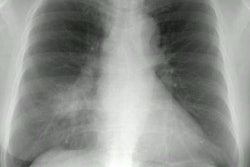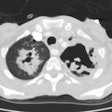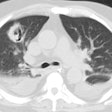Ascariasis:
Clinical:
Ascariasis (Ascaris lumbricoides) is also known as round worm. Infection is common in tropical and subtropical areas, but it is the third most common helminthic infection in the US after hookworm and trichuriasis [3]. It is the most common cause of peripheral blood eosinophilia with pulmonary opaicites [2]. Ingested eggs release their larvae in the duodenum [3]. Before the parasites can mature in the small intestine, the larvae must migrate through the pulmonary circulation, break out of the alveoli, be carried up the respiratory tract, and be re-swallowed [3]. The larvae then mature in the small bowel where the adults produce their eggs that pass in the feces [3]. Praziquantel is used for treatment [3].
When the larvae migrate to the lungs they incite patchy, migratory alveolar infiltrates and blood eosinophilia. The infiltrates usually clear over 10 days. Similar infiltrates can also be seen in other parasitic infections including hookworm and Strongyloides, or as an allergic drug reaction. Lobar consolidation and alveolar hemorrhage have also been described [1].
REFERENCES:
(1) Radiographics 2005; Martinez S, et al. Thoracic manifestations of tropical parasitic infections: a pictoral review. 25: 135-155
(2) Radiographics 2007; Jeong YJ, et al. Eosinophilic lung diseases: a clinical, radiologic, and pathologic overview. 27: 617-639
(3) Radiographics 2009; Catalano OA, et al. Biliary infections: spectrum of imaging findings and management. 29: 2059-2080
